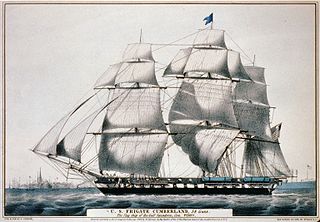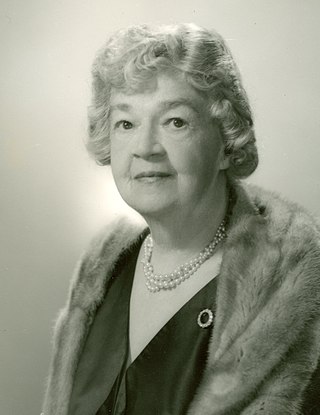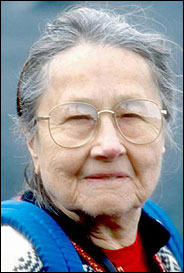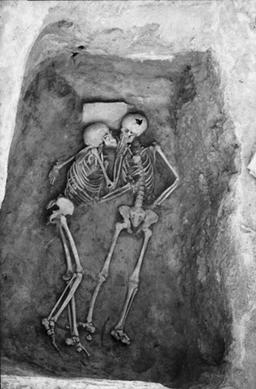Related Research Articles

The first USS Cumberland was a 50-gun sailing frigate of the United States Navy. She was the first ship sunk by the ironclad CSS Virginia.

United States Naval Reserve (Women's Reserve), better known as the WAVES (for Women Accepted for Volunteer Emergency Service), was the women's branch of the United States Naval Reserve during World War II. It was established on July 21, 1942, by the U.S. Congress and signed into law by President Franklin D. Roosevelt on July 30. This authorized the U.S. Navy to accept women into the Naval Reserve as commissioned officers and at the enlisted level, effective for the duration of the war plus six months. The purpose of the law was to release officers and men for sea duty and replace them with women in shore establishments. Mildred H. McAfee, on leave as president of Wellesley College, became the first director of the WAVES. She was commissioned a lieutenant commander on August 3, 1942, and later promoted to commander and then to captain.

The United States Navy Nurse Corps was officially established by Congress in 1908; however, unofficially, women had been working as nurses aboard Navy ships and in Navy hospitals for nearly 100 years. The Corps was all-female until 1965.

Edith Rogers was an American social welfare volunteer and politician who served as a Republican in the United States Congress. She was the first woman elected to Congress from Massachusetts. Until 2012, she was the longest serving Congresswoman and was the longest serving female Representative until 2018. In her 35 years in the House of Representatives she was a powerful voice for veterans and sponsored seminal legislation, including the Servicemen's Readjustment Act of 1944, which provided educational and financial benefits for veterans returning home from World War II, the 1942 bill that created the Women's Army Auxiliary Corps (WAAC), and the 1943 bill that created the Women's Army Corps (WAC). She was also instrumental in bringing federal appropriations to her constituency, Massachusetts's 5th congressional district. Her love and devotion to veterans and their complex needs upon returning to civilian life is represented by the Edith Nourse Rogers Memorial Veterans Hospital in Bedford Massachusetts that is named in her honor.

Teppe Hasanlu or Hasanlu Tepe is an archeological site of an ancient city located in northwest Iran, a short distance south of Lake Urmia. The nature of its destruction at the end of the 9th century BC essentially froze one layer of the city in time, providing researchers with extremely well preserved buildings, artifacts, and skeletal remains from the victims and enemy combatants of the attack. The site was likely associated with the Mannaeans.
Women's Armed Services Integration Act is a United States law that enabled women to serve as permanent, regular members of the armed forces in the Army, Navy, Marine Corps, and the recently formed Air Force. Prior to this act, women, with the exception of nurses, served in the military only in times of war. During World War II, over 150,000 women had served in the WAVES and the Women's Auxiliary Army Corps and were still serving when the act was enacted. Women also took part in the SPARS, which was created by the Coast Guard, and the Marine Corps Women's Reserve, during the war. In total, 350,000 American women joined and served during World War II. Section 502 of the act limited service of women by excluding them from aircraft and vessels of the Navy that might engage in combat.

SPARS was the authorized nickname for the United States Coast Guard (USCG) Women's Reserve. The nickname is an acronym fashioned from the USCG's motto, "Semper Paratus"—"Always Ready" (SPAR). The Women's Reserve was established by the U.S. Congress and signed into law by President Franklin D. Roosevelt on November 23, 1942. The law authorized the USCG to accept women into its Women's Reserve as commissioned officers and at the enlisted level for the duration of World War II plus six months. Its purpose was to release male officers and enlisted men for sea duty by replacing them with women at shore stations. This same month, Dorothy C. Stratton was appointed director of the Women's Reserve and given the rank of lieutenant commander. She was later promoted to captain.

Joy Bright Hancock, a veteran of both the First and Second World Wars, was one of the first women officers of the United States Navy.

United States Marine Corps Women's Reserve (Reserve) was the World War II women's branch of the United States Marine Corps Reserve. It was authorized by the U.S. Congress and signed into law by President Franklin D. Roosevelt on 30 July 1942. Its purpose was to release officers and men for combat, and to replace them with women in U.S. shore stations for the duration of the war plus six months. Ruth Cheney Streeter was appointed the first director. The Reserve did not have an official nickname as did the other World War II women's military services.

Loretta Perfectus Walsh became the first American active-duty Navy woman, the first woman to enlist in the U.S. Navy, and the first woman allowed to serve as a woman in any of the United States armed forces, when she enlisted as a sailor in the U.S. Naval Reserve on March 17, 1917. Walsh subsequently became the first woman U.S. Navy petty officer when she was sworn in as Chief Yeoman on March 21, 1917.

The yeoman rate is one of the oldest rates in the U.S. Navy, dating back to 1794. Historically, the Navy yeomen were responsible for keeping the storerooms for the ship's gunners, carpenters and boatswains. With the transition from sail to steam, yeomen were assigned to the ship's engineers. In the modern Navy, a yeoman is an enlisted service member who performs administrative and clerical work.

The Women's Royal Canadian Naval Service was an element of the Royal Canadian Navy that was active during the Second World War and post-war as part of the Royal Canadian Naval Reserve until unification in 1968. The WRCNS was in operation from October 1942 to August 1946.

Frederica ("Freddy") Annis Lopez de Leo de Laguna was an American ethnologist, anthropologist, and archaeologist influential for her work on Paleoindian and Alaska Native art and archaeology in the American northwest and Alaska.
This is a timeline of women in warfare in the United States from 1900 until 1949.

American women in World War II became involved in many tasks they rarely had before; as the war involved global conflict on an unprecedented scale, the absolute urgency of mobilizing the entire population made the expansion of the role of women inevitable. Their services were recruited through a variety of methods, including posters and other print advertising, as well as popular songs. Among the most iconic images were those depicting "Rosie the Riveter", a woman factory laborer performing what was previously considered man's work.

The Hasanlu Lovers are a pair of human remains found at the Teppe Hasanlu archaeological site, located in the Naqadeh in the West Azerbaijan Province of Iran. Around 800 BCE, the city of Hasanlu, located in north-western Iran, was destroyed by an unknown invader. Inhabitants were slain and left where they fell. In 1973, the lovers were discovered by a team of archaeologists from the University of Pennsylvania led by Robert H. Dyson.
Holly Pittman is a Near Eastern art historian and archaeologist, and an expert in Near Eastern glyptic art. She is the Bok Family Professor in the Humanities and a Professor in the History of Art Department of the University of Pennsylvania and serves as a curator in the Near East Section of the University of Pennsylvania Museum of Archaeology and Anthropology. Before joining the University of Pennsylvania, she was a curator of Ancient Near Eastern Art at the Metropolitan Museum of Art from 1974 to 1989. Since 1972, she has conducted archaeological excavations throughout the Middle East, including projects in Syria, Turkey, Cyprus, Iran, and Iraq. In 2019 she began directing new excavations at the site of Lagash in southern Iraq.
Katherine "Kay" Keating was an American military servicewoman, pharmacist, female veterans activist and business owner. She served with the Women Accepted for Volunteer Emergency Service (WAVES) in World War II and subsequently with the Navy Medical Service Corps. She achieved several milestones during her military career, including being the first female pharmacist in the US Navy, the first woman in the US Navy to advance in rank from seaman to captain, and the first female pharmacist to attain the rank of captain. After her retirement from active service, she operated a bed and breakfast and horse ranch in Beulah, Colorado. She was inducted into the Colorado Women's Hall of Fame in 2008.
Elin Corey Danien (1929–2019) was an American anthropologist and scholar of ancient Maya ceramics. She was an expert on Chamá pottery: polychrome, cylindrical vases produced in the eighth century CE in the highlands of what is now Guatemala. After earning BA, MA, and PhD degrees from the University of Pennsylvania, Danien worked at the Penn Museum, where she conducted and published research, developed exhibits, initiated public outreach events including "Member's Nights" and an annual "Maya Weekend", and later, after retirement, volunteered as a docent. She co-founded the Museum's Pre-Columbian Society, which gathered professional and amateur scholars interested in indigenous peoples of the Americas. As a philanthropist, she founded a scholarship program called Bread Upon the Waters which gave women over age thirty the opportunity to pursue and complete undergraduate degrees at the University of Pennsylvania through part-time study. A colleague remembered her as someone who was "more than a force of nature," and who often claimed that, "Archaeology is the most fun you can have with your pants on."
References
- ↑ The National WWII Museum (2012-07-30). "WAVES Break Through". The National WWII Museum Blog. Retrieved 2020-05-01.
- ↑ "Expedition Magazine - Penn Museum". www.penn.museum. Retrieved 2020-03-26.
- ↑ Internet Archive (1993). "Mary Virginia Harris". archive.org. Retrieved March 26, 2020.
- 1 2 Penn Museum (1993-03-08), Mary Virginia Harris , retrieved 2020-03-26
- 1 2 "The University of Chicago Magazine: August 2004". magazine.uchicago.edu. Retrieved 2020-03-26.
- ↑ Levine, Beverly (2001). World War II, We Were There: An Anthology. iUniverse. ISBN 978-0-595-19216-8.
- ↑ Asal, Alex (June 11, 2019). "Learning to "Be Navy"". Smith College. Retrieved May 1, 2020.
- ↑ Harris, Mary Virginia (1944). Guide Right: A Handbook for WAVES and SPARS. New York: The MacMillan Company.
- ↑ "Bellevue Memorabilia Collection" (PDF). The Historical Society of Pennsylvania. January 2007. Retrieved 2020-03-26.
- ↑ "Expedition Magazine - Penn Museum". www.penn.museum. Retrieved 2020-03-27.
- ↑ Harris, Mary Virginia (1989). "Glimpses of an Iron Age Landscape". Expedition. 31:2-3: 12–23.